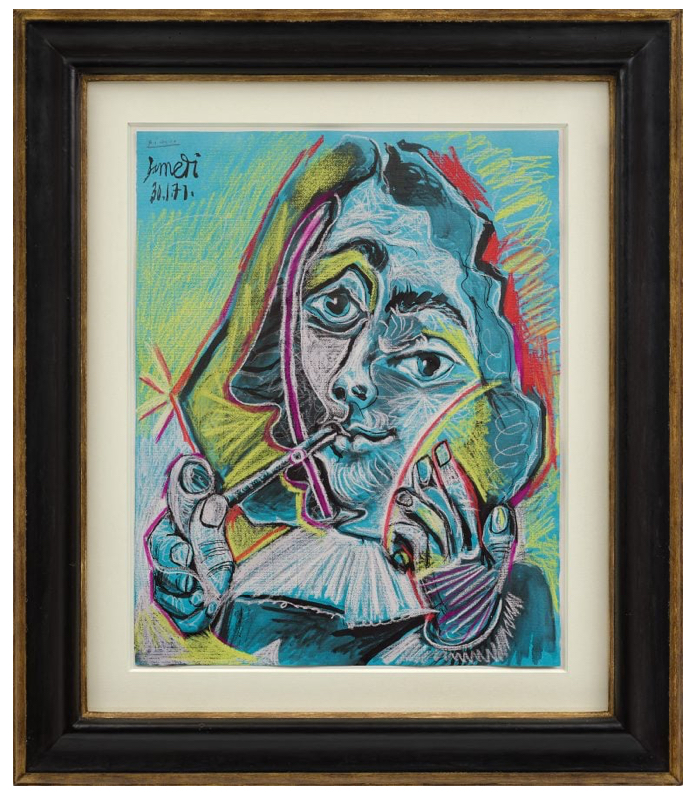In the final years of Pablo Picasso’s life, the artist produced works that many critics once deemed erratic, excessive, even grotesque. But time has reframed these late paintings as deeply poignant expressions of a man confronting the inexorable passage of time. One of the most striking examples from this period is Tête d’homme à la pipe (1971), a vivid portrait that exemplifies the intensity, eccentricity, and genius of Picasso’s twilight years. It is a work less about aesthetic perfection and more about existential truth—a portrait not of a man, but of manhood, time, and the artist’s own image refracted through history, myth, and imagination.
Painted when Picasso was ninety years old, Tête d’homme à la pipe belongs to a prolific and psychologically rich era often referred to as his “late period” or “last works.” In these paintings, Picasso eschewed technical polish in favor of raw immediacy. Gone were the tight cubist geometries or classically modeled forms; what remained was pure impulse—emotion laid bare in color and form. This painting, with its quick brushwork and wild palette, bursts with the energy of someone who senses the end but refuses to succumb to stillness. Rather than retreat, Picasso pressed forward, innovating at the threshold of his mortality.
The subject of the painting is emblematic: a male figure—perhaps a musketeer, perhaps Picasso himself—rendered in large strokes and hot colors, pipe in mouth, gaze burning outward. The pipe is no trivial inclusion. Throughout art history, smoking figures have suggested contemplation, a pause between action and memory. Here, the pipe becomes a symbol of reflection, of nostalgia, but also of resistance. It marks the figure as rooted in ritual, masculinity, and a world that once was.
But this is no romantic portrait. The face is exaggerated, with asymmetry that borders on the absurd. The eye is wide and alert; the features distorted. The lines dance between caricature and elegy. It is as if Picasso, aware of his own deterioration, projected his fears and fantasies into the figure—making the act of painting itself a form of wrestling with fate. Critics of the time, often unkind, missed the point: this wasn’t degeneration but a redefinition of artistic potency. In this late work, Picasso wielded his brush like a weapon against the void.
It’s crucial to place Tête d’homme à la pipe within the larger continuum of Picasso’s late oeuvre, especially the so-called “Musketeer” series. Beginning around 1966, these figures—drawn from 17th-century romantic and literary archetypes—populated his canvases with bravado, humor, and melancholy. For Picasso, they represented both a return to his Spanish roots and an imaginative escape into the past. The musketeers, with their plumed hats, ruffled collars, and unruly hair, were avatars—masks behind which the artist could meditate on virility, nostalgia, and death.
Yet Tête d’homme à la pipe strips much of the romanticism away. While the figure retains the iconography of a musketeer—the robust head, the confident pipe—it is undone by its own deconstruction. The colors bleed; the features collapse into one another. There is little concern for harmony. What dominates instead is intensity. This shift underscores a psychological reckoning. Here, Picasso is not only chronicling masculine strength; he is confronting its limitations. The painted man is neither idealized nor defeated—he is simply enduring.
The year 1971 also holds significance. It marked the artist’s ninetieth birthday, a moment that turned the art world’s eyes once again toward him. Retrospectives were held, and tributes poured in. Yet rather than resting on his reputation, Picasso worked relentlessly, producing more than 200 pieces that year alone. In Tête d’homme à la pipe, this prolific urgency is palpable. The paint moves like breath across the canvas, suggesting not deliberation but instinct. It’s as if Picasso painted faster to outrun time itself.
While Tête d’homme à la pipe is rich with historical and personal context, it also speaks to broader themes in the visual arts. It challenges the notion that creativity wanes with age. Much like late works by Titian, Rembrandt, or Matisse, Picasso’s painting stands as a testament to artistic vitality in old age. It asserts that late style need not be reflective or subdued—it can be radical, even rebellious. This painting, in all its feverish color and furious distortion, doesn’t seek to resolve or summarize a career. It seeks to burn with it.
The reception of this painting—particularly its sale through the digital auction platform Fair Warning—further complicates its legacy. Fair Warning, founded by Loïc Gouzer, represents a new frontier in the art market: curated, invitation-only sales that hinge on exclusivity and rapid digital bidding. The inclusion of Tête d’homme à la pipe in such a context reinserts Picasso’s work into contemporary conversations about value, legacy, and relevance. It is both artifact and commodity, revered and recirculated. That this work, created by a nonagenarian in solitude, now commands attention in the slick, transactional world of high art speaks to its enduring gravity.
Yet even beyond auctions and critical reassessments, Tête d’homme à la pipe endures for its emotional force. There is something deeply human in the figure’s uneven gaze and clenched jaw. He looks not into the past, but squarely at us—smoke curling from his lips like a whisper of defiance. In that expression lies Picasso’s final provocation: to feel, to struggle, to keep going. And to paint.
In the end, Tête d’homme à la pipe is less a conclusion than a combustion. It doesn’t explain Picasso’s life or distill his legacy into a neat summation. Rather, it leaves us with the crackle of an unresolved fire, still alight, still dangerous. As viewers, we are left to inhale the smoke, to trace the ash, to marvel at the furnace that was Pablo Picasso—even at ninety, still holding the brush like a sword.
No comments yet.








